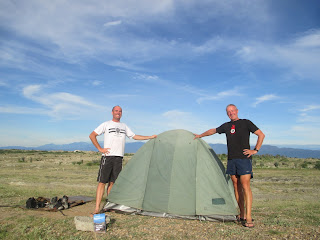We left Bogota and were heading in the direction of San Agustin to the south west but would be sipping half way to experience the sights on offer. We were travelling in the same direction as an old railway line most of which had disappeared except a few bridges and roads or footpaths in towns where the tracks had been. Evidence of the old railway line including rails.
Most cities and towns seemed to boast a roundabout with some form of adornment in the middle...and here in Episnal was another one...depicting a farmer and some sacks of produce.
The terrain was getting flatter and drier.
And despite the supposed lack of water, here were some fish farms en route.
We were bumping along a dirt track to get to our destination and suddenly we turned a corner and there was a tunnel through a hill...followed by a bridge across a wide river, Rio Magdalena...
with views up and down the river...
And then we got to the point the journey...Colombia's desert. Although it is not actually a desert as the area receives 1070mm of rain a year, but most of it is captured by the mountains and flows into the rivers and the area between the two mountain ranges is caught in a rain shadow. Rather than water the land, the water runs off into the rivers so there is water for fish farming and rice paddies next to the rivers but other areas are left dry. The area is technically a semi arid tropical forest.
But it looks like a desert to me!
We stopped in the town of Villavieja in the square dominated by the church and other than a small palaeontology museum, there is little else of interest for the tourist.
Then it was off deep into the 'desert' to see some of the unusual formations, the cacti and other flora and fauna.
The area is reputed to have little light pollution and is an excellent area for star gazing and we passed two mall observatories as we made our way through the desert, still bumping along dirt tracks.
Then it was on down the valley, It was a long circular route to take trekkers past some of the interesting sights, such as these unusually weathered rock formations in cliffs...
some pinnacles of rocks...
and more stand alone pinnacles...
Some of the cacti were starting to flower such as these barrel cacti but there best show would be in a weeks time.
The narrow gorge widened into a flat valley with low sides.
And there were more strange rocks...
and a close up of some some pebbles embedded in the sandstone.
And lastly a picture of me on the right and my tent buddy, Shane in the white T-shirt and our faithful tent, named Spider Monkey which has served well over the last eight months and this was also to be our last night under canvas so it was farewell to Spider Monkey.



































































